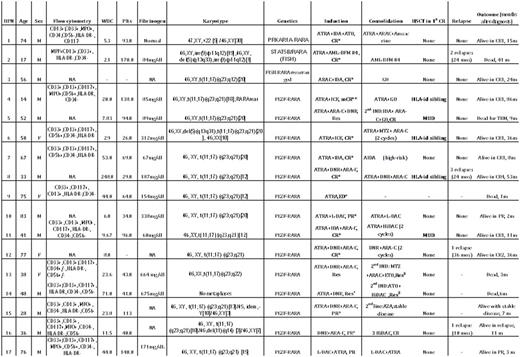Abstract
Background. Acute promyelocytic leukemia (APL) is a subtype of acute myeloid leukemia (AML) characterized by the translocation t(15;17) (q22;q21) generating the PML-RARA fusion gene. In rare cases of AML with APL like-morphology, RARA can be fused to an alternative partner other than PML (e.g. PLZF, NPM1 , NUMA1 , STAT5B, PRKAR1A and others) and this genetic heterogeneity accounts for the different sensitivity to targeted agents, such as all- trans retinoic acid (ATRA) and arsenic trioxide (ATO).
Patients and methods. We collected data on 17 patients with AML characterized by variant RARA fusions, diagnosed between 2005-2017 from 13 institutions in US, Europe, Brazil, India and Australia. Of the 17 patients, 14 harboured PLZF-RARA, 1 PRKAR1A-RARA , 1 STAT5b-RARA rearrangements and 1 t(11;17)(q23;q21) with rearranged RARA.
Results. Morphological data were compatible with classical M3 AML in all cases, and 38% presented with laboratory signs of coagulopathy. Flow cytometry was available in 12/17 cases and was compatible with classical APL, with 5/12 patients (42%) expressing CD56. Three cases were therapy-related AML due to previous exposure to radio-chemotherapy for solid tumors. Complete clinical-biological data are shown in Table 1. Most patients were adults (age range, 28-83 years), only two being younger than 18 years. Median WBC and platelet counts were 15.7 x 109/L (range, 2.18-248) and 69 x 109/L (range, 26-170), respectively, with 53% of patients presenting with WBC >10 x 109/L. Fourteen out of 17 patients received induction with ATRA + chemotherapy (CHT), either intensive or low-dose based on age and performance status. In addition, one patient received ATO combined with CHT and ATRA, 1 CHT alone and 1 ATRA alone. After induction, 11 patients achieved complete morphologic remission (CR) (of whom 2 after a second induction cycle); 2 are currently in partial remission (PR), 1 died early due to acute renal failure and 3 had resistant disease and received re-induction therapy that resulted in progressive disease in 2 and stable disease (SD) in one patient. Overall, the CR rate after induction therapy was 65%. Of the 13 patients who underwent consolidation therapy, 8 received ATRA+CHT, 2 CHT alone, 2 gemtuzumab ozogamicin (GO), and 1 azacytidine. Five of these patients underwent subsequent allogeneic hematopoietic stem cell transplant (HSCT) in first CR (3 from an HLA-matched sibling and 2 from matched unrelated donors). Four patients relapsed during follow-up (3 PLZF-RARA and 1 STAT5b-RARA ). Of these, 1 died of disease progression, 2 are alive in CR2 and CR4, respectively, and 1 is currently undergoing salvage therapy. With a median follow-up of 11 months (range: 1 - 86), 12/17 patients are alive (70.5%); of these, 9 are alive in CR, 2 are alive in PR and 1 alive with SD. Overall, five patients (29.5%) died, 3 from disease progression, 1 from transplant-related complications and 1 from acute renal failure during induction therapy.
Conclusions. Despite the reported poor sensitivity of these RARA variants to standard APL therapy, this series suggests a relatively favorable outcome after treatment with ATRA combined with AML-like regimens including, in younger patients, allogeneic HSCT.
The relative contribution of ATRA to achievement of CR and consolidation of remission remains to be further investigated.
Table legend.
*CR, complete remission; **mCR, molecular complete remission;+Res, resistant disease; °ED, early death;§PR, partial remission
ATRA, All-trnas retinoic acid; IDA, idarubicin; DNR, daunorubicin; GO, gemtuzumab ozogamycin; ARA-C, cytaranine; L-DAC, low-dose cytarabine; HiDAC, high-dose cytarabine; MTZ, mitoxantrone; ETO, etoposide; ATO, arsenic trioxide;
HSCT, hematopoietic stem cell transplantation;MUD, matched unrelated donor
Cicconi: TEVA: Speakers Bureau. Montesinos: Celgene Corporation: Honoraria, Research Funding. Schwarer: Novartis: Honoraria, Membership on an entity's Board of Directors or advisory committees, Speakers Bureau; BMS: Honoraria, Membership on an entity's Board of Directors or advisory committees, Speakers Bureau; Celgene: Honoraria, Membership on an entity's Board of Directors or advisory committees, Speakers Bureau; Specialised Therapeutics: Honoraria, Membership on an entity's Board of Directors or advisory committees, Speakers Bureau; Amgen: Honoraria, Membership on an entity's Board of Directors or advisory committees, Speakers Bureau. Lo Coco: TEVA: Honoraria, Speakers Bureau; Novartis: Honoraria, Speakers Bureau; Lundbeck: Honoraria, Speakers Bureau.
Author notes
Asterisk with author names denotes non-ASH members.


This feature is available to Subscribers Only
Sign In or Create an Account Close Modal